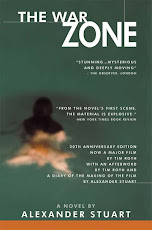Mia Kirshner’s I Live Here Gives Voice to the Gone
By John Hood
The world can be an unfriendly place: famine, war, oppression, disease, crime. Other people can conspire to make it unfriendlier still. No one knows this better than the refugee, those who’ve been displaced from their homes, their country, and often their very lives, as a result of all the globe’s ugliness.
Not every refugee achieves their status through geography, of course. In fact, some are locked up and locked out right at home, forced to slave for wages never paid, and made to endure conditions beyond in the most vivid imagination.
But whether they live in a camp or a barrio, the one thing that unites every refugee is their silence, for these are the people who not only have no say; they have no voice.
Thankfully there are more fortunate folks among us who are compelled to give the refugee the voice they’ve been denied, folks like the Canadian-born alt-starlet Mia Kirshner, who with a little help of friends like Adbusters’ Paul Shoebridge and Michael Simons, award-winning non-fictionist James MacKinnon, graphic novelist Joe Sacco and award-winning writer Chris Abani, has just published a remarkable assemblage of refugee stories entitled I Live Here (Pantheon, $29.95).
Kirshner, of course, is the crazy bad girl in Showtime’s hit series The ‘L’ Word (among other endeavors), which means she’s got a voice big enough to be both reckoned with and listened to. Oh, Mia’s not in any way preachy, she’s just determined to do whatever it takes to make this world a better place to live in for those whose lives are lived in the margins.
To that end Kirshner visited refugee camps in Malawi, Ingushetia and Burma, where AIDS, oppression and war have forced untold thousands to flee, in addition to the barrios of Juarez, Mexico, where legions of youngmaquiladora-employed women have been disappearing without a trace. I Live Here, a composite of four notebooks designed to be taught, read, spoken of and remembered, not only chronicles the lives she encountered, but it gives them each a voice.
I had the great, good pleasure of interviewing the delightful and committed actress during this year’s Miami International Book Fair — here’s some of our conversation:
First the obvious: Why is the book titled I Live Here?
My partner on the book Mike Simons came up with that title and the scratched out ‘here’ on the cover, and I think it’s because all of these stories are about people who don’t have homes but they still exist. Survival is their existence.
How’d Adbusters get involved?
I was a huge fan of their work, and after Joe Sacco said ‘Yes’ to the project I wrote them a letter and they said ‘Yes’ too.
So you didn’t know them beforehand?
I didn’t know anybody. Basically I did almost a year of research, then I put together a really crude mock book of what I wanted it to look like and what I wanted the content to be, and I wrote a passionate letter to Joe…
That you still wish you had a copy of?
Ugh, fuck, yeah, you shouldn’t…
I’m sorry, I shouldn’t have brought it up. But I read somewhere that you wished you still had a copy of that letter because it was the catalyst for everything.
It was because he said ‘Yes,’ and he volunteered his time, and he sort of set the bar for the other artists.
And you thought it would take seven months, a year tops…
I thought it would take a year… Oh man, you’ve really been reading up on this.
What about Chris Abani, the Nigerian writer, how’d he get involved?
Do you know him?
Well, I know his work. Akashic has published a couple of his novellas.
Well, that was actually Amnesty International who introduced me [to Chris] and we formed a really beautiful friendship.
He’s a cool cat, right?
He’s wonderful. He wrote the curriculum for the creative writing program. And Chris is the one who really came through after Pantheon said I had to write for the book.
But what would you have been otherwise — the coordinator?
It was more than that. Because I went and I collected the material, and I was shaping the stories, and every page Mike, Paul and I designed together. They did the actual handwork.
Now, though, at least 50 percent of the book is your writing, right?
Yes, now, but back then I was really bummed out.
Really?
Yeah, and I get it. I mean, it’s their money, right? But I asked why they wanted me to do this. I wasn’t going to talk about my day job, because it’s not about that. One had nothing to do with the other. So Chris just walked me through the process. He said ‘write as if you’re writing a letter’ and I guess I just made a decision that since I’d asked people to write about such personal things, I would too.
You have to admit, though, that had you not had this ‘day job’ it would’ve been a lot more difficult to get the book published.
I know.
I read somewhere that there were four more books planned and you were thinking about Iran and Colombia and Cuba.
And Pakistan.
Are you just naturally drawn to places that are almost off the map?
I think so. I think I’ve always sort of gravitated towards the weirdoes and the outsiders and the people who sort of didn’t have the money and didn’t have the luck, so I think it’s a natural progression for me to want to do stories that are hidden. Does that make sense?
It makes perfect sense. But aren’t there stories right here that are equally compelling?
Sure there are, and I [also] want to do a domestic book. There are so many people living in Canada and the U.S. who don’t speak the language and don’t have jobs and are living in packed apartments and are totally isolated. And I’m interested in their stories as well.
Meantime we have the striking design, the foundation, a YouTube channel and you’re on a tour of support. Why so much effort?
I worked for seven years on this and I put my saving into this, so I want the book to sell. And because I think its heart is pure.
For further information about the efforts and intentions behind I Live Here, visit i-live-here.com.
Comments? E-mail lee@miamisunpost.com.
All contents copyright © 2008 Caxton Newspapers, Inc.












